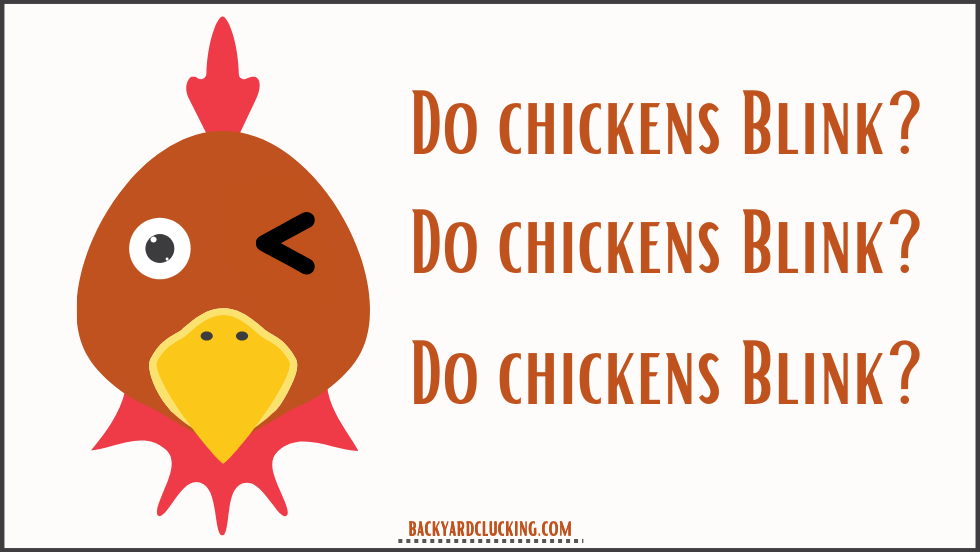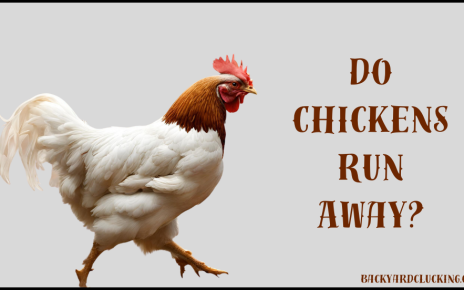Many people who raise chickens, and even those who encounter them daily, find themselves curious about these birds’ behaviors and biological intricacies. One question frequently arises regarding their blinking habits: do chickens blink?
The lack of clear, accurate information about such a seemingly simple question can lead to misconceptions and confusion. It may even influence how chicken owners care for their birds if they need to understand their natural behaviors fully.
Our comprehensive guide provides scientifically backed, clear, and straightforward answers to such questions. We delve into the intricacies of chicken physiology and behavior, debunking myths and giving practical insights. Whether you’re a chicken owner or just a curious mind, our guide is designed to keep you informed and confident in your knowledge of these fascinating creatures.
Do Chickens Blink?
While chickens possess eyelids, their movement isn’t quite similar to ours. In the conventional sense, the blink of a chicken is a rare sight, but there’s a good reason why.
Consider this from a wildlife perspective; it’s pretty logical. Chickens are near the bottom of the food chain, with only bugs ranking lower. They are prey material, hence, the need for top-notch defensive instincts.
Unfortunately, chickens are neither swift fliers nor fast runners. So, what’s their defense mechanism? Safety lies in their numbers, but that’s only effective if they are aware of an approaching predator.
That’s where their eyes play a crucial role. Their eyes are remarkable, a fact we’ll delve into as we progress in this article. However, these eyes serve little purpose if they remain closed.
But then, how do they prevent dirt from landing in their eyes? The following section will shed light on this.
Anatomy of a Chicken’s Eye: A Look into the Avian World
Chickens may be familiar in farms and backyards, but have you ever wondered how they see the world? As it turns out, the anatomy and function of a chicken’s eye are pretty different from human eyes, allowing them to navigate their environment in unique ways.
In this article, we’ll explore the intricate structure of a chicken’s eye, the purpose of their specialized eyelids, and how they use their vision to thrive in their surroundings.
A Colorful Perspective
One of the most fascinating aspects of a chicken’s eye is its ability to see a more comprehensive range of colors than humans. Chickens have a broader color spectrum due to additional cone cell types in their retinas.
While humans have three types of cones that enable us to perceive red, green, and blue colors, chickens have additional cones that allow them to detect ultraviolet (UV) light.
This UV sensitivity aids them in various tasks, such as finding food, identifying predators, and selecting mates.
A study by József Vígh from the University of Guelph in Canada showed that chickens could detect changes in the spectral composition of light and use this information to synchronize their body rhythms with the environment.
This ability to perceive subtle shifts in light helps them regulate their daily activities and maintain a healthy circadian rhythm.
Unique Structures in a Chicken’s Eye
Chickens have two foveae, unlike human eyes, which have a single fovea – a small, central pit in the retina with an abundance of cone cells for sharp, detailed vision.
The deep fovea is used for viewing objects at a distance, while the shallow fovea is used for perceiving things closer to them. This dual foveal system is crucial for tasks such as seed pecking, where accurate depth perception is essential, and scanning for aerial predators to remain vigilant.
Recent research by Dr. Andrew Gallup at SUNY Polytechnic Institute has revealed that chickens possess an additional layer in their retinas called the double cone, which allows them to detect movement and changes in brightness much quicker than humans. This heightened motion detection helps them react swiftly to danger and maintain their position within their social group.
A Blink of an Eye: Chickens’ Specialized Eyelids
One of the most interesting differences between human and chicken eyes is their unique eyelid structure. While humans have an upper and lower eyelid, chickens possess a third, translucent eyelid known as the nictitating membrane.
The nictitating membrane, located in the inner corner of the eye, can be drawn across the eye to protect it from foreign debris, provide lubrication, and even aid in perceiving fast-moving objects.
This additional eyelid allows chickens to maintain their vision while protecting their eyes from potential environmental hazards, such as dust, dirt, and pecking from their fellow flock members.
Practical Applications and Insightful Anecdotes
Using the intricacies of a chicken’s eye, researchers are exploring ways to apply their visual capabilities to other fields. For example, innovators are investigating the use of UV-reflective surfaces for deterring birds from power lines and the potential benefits of UV-enhanced lighting for poultry welfare.
In a quirky anecdote about the link between vision and behavior, Dr. Peter Taylor from the University of Bristol, who studied the effects of changing light levels on chickens, proclaimed, “Chickens kept in the dark believe every morning is Saturday.”
So, while chicken owners can rest easy knowing that their birds will not be at risk of eye strain from too much blinking, they may still have to practice patience if their birds don’t know which day it is!
Do Chickens Close Their Eyes When They Sleep?
Chickens close their eyes when they sleep, but it is common for them to keep one eye open at a time. This is because chickens can control each eye with one side of their brain, allowing them to move their eyes independently and rest one side at a time. This adaptation is advantageous for staying vigilant against predators, even during sleep.
Yes, this phenomenon indicates that chickens have the remarkable ability to experience wakefulness and sleep simultaneously. .
When one hemisphere of the brain is in a sleep state, the corresponding eye also exhibits signs of sleep.
It is worth noting that brain hemispheres control the opposite side of the body. This parallels the organization in humans, where the right hemisphere governs the left hand’s movements.
The dominant hens within the flock typically position themselves in the center of the coop and sleep with both eyes closed, ensuring optimal rest.
One can surmise that this is one of the advantages the queen hen enjoys.
On the other hand, the remaining hens sleep with one eye open to remain vigilant against potential predators.
It is intriguing to observe their ability to accomplish this, which stems from their evolutionary adaptation due to the persistent threat of nocturnal predators such as:
- Raccoons
- Skunks
- Opossums
- Owls
- Mink
- Weasels
Why do chickens have 2 eyelids?
Chickens have two eyelids, a lower and an upper, just like humans. However, chickens also possess a third translucent eyelid known as the nictitating membrane, which is situated in the inner corner of the eye. This additional eyelid helps keep their eyes protected from foreign debris, provides lubrication, and even aids in processing fast-moving objects to help them react swiftly to danger.
Additionally, the nictitating membrane helps regulate the amount of light that enters the eye, which is helpful for activities such as night-time foraging. This adaptation is especially beneficial for chickens living in an environment with varying daylight conditions.
The ability to keep one eye open while sleeping is also made possible by this third eyelid, as it helps regulate the amount of light entering the eye when one hemisphere of the brain is in a sleep state. This adaptation provides chickens with an advantage against predators that may be present at night.
Interesting Facts about Chicken Vision
- A chicken’s eyes account for approximately 10% of its total head mass.
- These avian creatures possess a 300-degree field of vision due to the positioning of their eyes on the sides of their heads.
- Remarkably, chickens are tetrachromatic, possessing four types of cones that enable them to perceive red, blue, green, and ultraviolet light.
- As a result, their visual spectrum encompasses a multitude of colors and shades beyond our human perception.
- Furthermore, chickens possess a unique double-cone structure that aids in tracking movement.
- Their heightened sensitivity allows them to detect subtle light fluctuations that remain invisible to us. Interestingly, the presence or absence of light can be discerned by chickens through their pineal gland, even in cases of complete blindness.
- To protect their eyes from dust and debris, chickens possess a third eyelid, the nictating membrane, which slides horizontally over their eyes.
- Additionally, chickens can utilize each eye independently for simultaneous tasks.
- However, it is worth noting that chickens have mono-vision, with the left eye being far-sighted and the right vision being near-sighted.
- This characteristic results from their positioning in the egg, wherein the right eye is exposed to light through the shell while the left eye is directed toward the body.
- Unfortunately, chickens possess inferior night vision due to their evolutionary history, as they descended from dinosaurs instead of coexisting with them in the dark.
Conclusion
It is time to close this article by acknowledging that chickens possess remarkable visual capabilities honed through centuries of evolution. From their massive field of vision to their unique double-cone structure, chickens are genuinely fascinating creatures with an extraordinary eye for detail. Additionally, they exhibit several adaptive behaviors, such as blinking and sleeping with one eye open to stay vigilant against predators.



